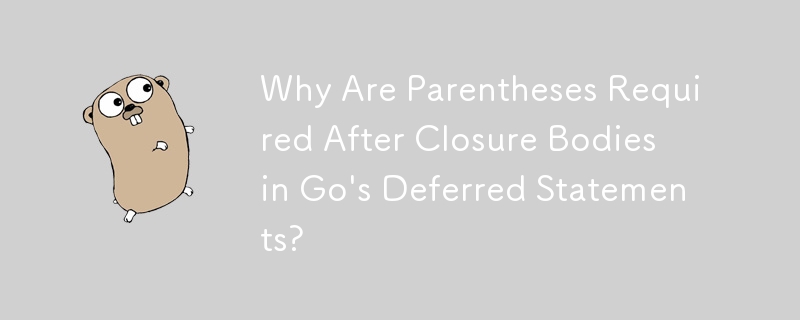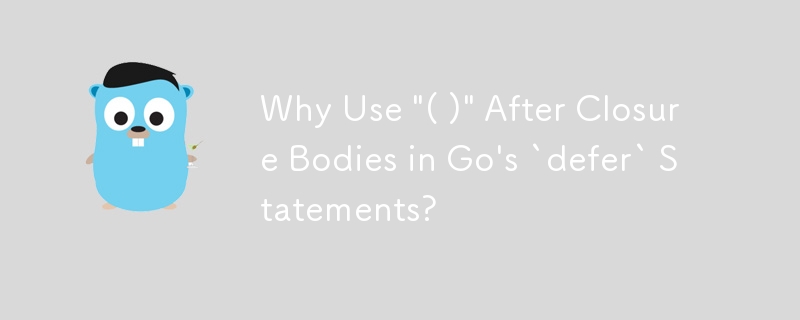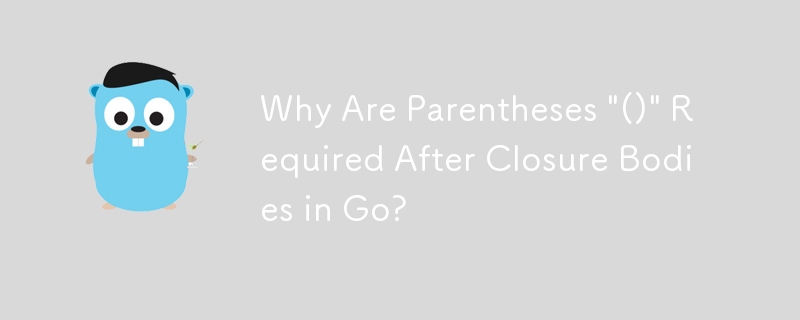
Course Introduction:Closure Invocations in GoIn Go, the usage of parentheses after the body of a closure is not limited to closure contexts. The core concept that...
2024-12-03 comment 0 512

Course Introduction:The Rationale Behind "( )" in Closure Bodies in GoIn Go, the addition of "( )" after a closure body is not specific to closures but rather applies...
2024-12-02 comment 0 875

Course Introduction:Closure Body Parentheses in GoIn Go, understanding the usage of parentheses after the body of a closure can be perplexing. Let's delve deeper into...
2024-12-09 comment 0 1181

Course Introduction:Understanding the Purpose of "()" in Closure Bodies in GoIn Go, it is not uncommon to encounter the use of "()" after a closure body, both in...
2024-12-04 comment 0 846

Course Introduction:Accessing the Closure of a JavaScript FunctionIn JavaScript, a function forms a closure by retaining a hidden link to its enclosing scope. This...
2024-11-03 comment 0 1074

Course Elementary 13782
Course Introduction:Scala Tutorial Scala is a multi-paradigm programming language, designed to integrate various features of object-oriented programming and functional programming.

Course Elementary 82301
Course Introduction:"CSS Online Manual" is the official CSS online reference manual. This CSS online development manual contains various CSS properties, definitions, usage methods, example operations, etc. It is an indispensable online query manual for WEB programming learners and developers! CSS: Cascading Style Sheets (English full name: Cascading Style Sheets) is an application used to express HTML (Standard Universal Markup Language).

Course Elementary 13150
Course Introduction:SVG is a markup language for vector graphics in HTML5. It maintains powerful drawing capabilities and at the same time has a very high-end interface to operate graphics by directly operating Dom nodes. This "SVG Tutorial" is intended to allow students to master the SVG language and some of its corresponding APIs, combined with the knowledge of 2D drawing, so that students can render and control complex graphics on the page.

Course Elementary 24596
Course Introduction:In the "AngularJS Chinese Reference Manual", AngularJS extends HTML with new attributes and expressions. AngularJS can build a single page application (SPAs: Single Page Applications). AngularJS is very easy to learn.

Course Elementary 27460
Course Introduction:Go is a new language, a concurrent, garbage-collected, fast-compiled language. It can compile a large Go program in a few seconds on a single computer. Go provides a model for software construction that makes dependency analysis easier and avoids most C-style include files and library headers. Go is a statically typed language, and its type system has no hierarchy. Therefore users do not need to spend time defining relationships between types, which feels more lightweight than typical object-oriented languages. Go is a completely garbage-collected language and provides basic support for concurrent execution and communication. By its design, Go is intended to provide a method for constructing system software on multi-core machines.
2018-11-11 18:44:45 0 1 1185
2019-09-23 09:33:31 0 0 1314
Can I use variables instead of closure functions?
2018-04-15 22:38:44 0 0 1353
laravel - How to understand Closure $next when defining middleware
2017-05-16 16:54:35 0 2 775